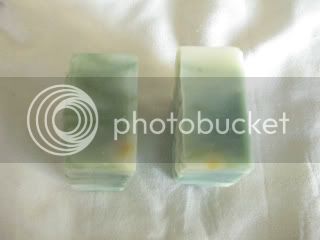Krisduff
Member
I've been making soap for almost a year now and have been really happy with all my results - until now. Two of my soap batches have developed DOS after 3 months and both are from the same recipe using different FO's (from the same company). Here is my recipe:
Olive Oil 32 oz (46.5%)
Coconut Oil 20 oz (29%)
Palm Oil 15 oz (22%)
Shea Butter 1.8 oz (2.6%)
Water 26oz
Lye 9.6oz
Superfat 7%
I mixed the lye and oils at 100F, added 2 tsp. liquid chlorophyll, .5 tsp powdered sage, and 3.25 oz margarita FO to one batch. For the other batch I added 1.5 oz Acai FO.
I brought both batches to a full gel, unmolded after 24 hours, set to cure on resin dry rack with excellent ventilation for 4 weeks and stored in plastic bins open at least a couple of inches for air flow. I use stainless steel pots to mix ingredients, plastic or glass measuring cups, plastic spoons, stainless steel soap cutters, and a lined Nizzy mold. Is it my recipe? I added the shea to the other oils I melted down. I haven't had any problems with any other recipes I've used therefore I don't think it's my oils. So far, 4 bars of the Margarita batch have developed orange spots and 1 bar of the Acai batch. What could it be? So frustrating!

Olive Oil 32 oz (46.5%)
Coconut Oil 20 oz (29%)
Palm Oil 15 oz (22%)
Shea Butter 1.8 oz (2.6%)
Water 26oz
Lye 9.6oz
Superfat 7%
I mixed the lye and oils at 100F, added 2 tsp. liquid chlorophyll, .5 tsp powdered sage, and 3.25 oz margarita FO to one batch. For the other batch I added 1.5 oz Acai FO.
I brought both batches to a full gel, unmolded after 24 hours, set to cure on resin dry rack with excellent ventilation for 4 weeks and stored in plastic bins open at least a couple of inches for air flow. I use stainless steel pots to mix ingredients, plastic or glass measuring cups, plastic spoons, stainless steel soap cutters, and a lined Nizzy mold. Is it my recipe? I added the shea to the other oils I melted down. I haven't had any problems with any other recipes I've used therefore I don't think it's my oils. So far, 4 bars of the Margarita batch have developed orange spots and 1 bar of the Acai batch. What could it be? So frustrating!





